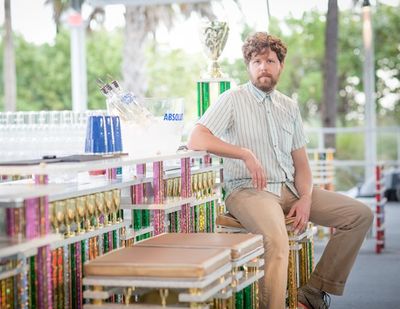Ry Rocklen

With the parties that accompany the most overtly glamorous art fair of them all, Art Basel in Miami Beach, it is apt that one of the many highlights of this fair was the social space designed by artist Ry Rocklen for Absolut. Rocklen was invited to produce the space as part of Absolut’s ongoing Art Basel project, in which artists are invited to produce art bars concurrent to the Art Basel fairs. For his commission, titled Night Court
, Rocklen produced a bar in which the furniture is made out of old trophies, an extension of a project with roots in 2011, when Rocklen produced his first sculpture using these objects, Second to None, and which evolved into the production of furniture pieces under the frame of Trophy Modern, which was presented in 2013 at Art Contemporary Los Angeles. In this interview, Rocklen talks about how the Trophy Modern project began, how it has evolved, and what the notion of trophy modernism means exactly.
I wanted to start with the idea behind trophy modernism, which suggests how victory is transient, given the way you use these old trophies as pure matter, essentially…
Well, take the sculpture I did in 2011, Second to None; that piece was all about how the materials of victory remain but the moment is lost and maybe the person is lost and the importance of the trophy is lost and yet the material remains. So there was something pathetic about finding all these trophies that were abandoned and in this state of limbo.
Then you showed a series of furniture pieces made from these trophies in 2013 at Art Contemporary Los Angeles, presented under the design title, Trophy Modern. I wanted to ask about the critical statement of inserting such literal “trophy objects” in an art fair space.
There is a kind of celebratory aesthetic to the trophies. They are as shiny as possible; there are these rainbow colours and it has all this bedazzlement. The objects end up looking like a sundae with every topping from the bin and it’s not necessarily going to be good-looking or good tasting. So that is sort of embodied in the trophies as material and the furniture designs themselves. In terms of the trophy object, there is the time signature of an artwork. We make things that we want to see stand the test of time, or that are indoctrinated into the great institutional time capsule, or in a collector’s house. We think of objects that are meant to escape their own time and go into the future.
I think in this particular setting the more cynical side of the trophy object was highlighted. Perhaps now in this particular climate there is that aspect that really pertains to the trophy object being bought by collectors and it’s slightly cheeky in a way because you are getting a trophy couch, but maybe that affect will evaporate and it will become a relic; like this was part of a culture back in the day.
How did you formulate the idea of trophy modernism?
It came to me in a more pragmatic way; it started with a thought to make furniture out of these trophy parts because practically, I knew I could do it. There is an essential design logic to trophy construction and I became quite familiar with this design logic in that sculpture, Second to None. And obviously there is this Greco-Roman aspect that is key to these trophies; the columns and the marble, and the figure; the naked man with the curly, Romanesque hair, maybe wearing a tunic. So that was implicit in that structure of trophy making and I capitalized on this existing system while thinking about how the designs would reflect this system. So everything is made as if it were a real trophy. I’m not taking any liberties with the construction. Everything is at a ninety-degree angle, for instance; all the marble slabs are going straight across. In this way, there is something very architectural to the trophy modern designs.
Thinking about this relation to architecture, did you instinctively choose the furniture object as a go-between or a bridge between the structures embedded in a modernist trophy object or trophy building, such as those produced by Le Corbusier?
Furniture is such a basic problem solving practice. The rules are set. A chair needs to support the weight of a person; there is this functional necessity that takes time to develop and is directed by our bodies. I like how furniture itself is reflecting this quintessential problem of how to accommodate the body; why chairs have a certain height is totally based on the body. I have this system that I realized could be modified to become furniture. So essentially it’s about problem solving and adapting. The furniture designs also can reflect on craftsmanship; I thought about Judd with his fascination and obsession with the right angle and how that is also reflected in the right angles in my furniture.
Thinking about how bodies dictate design, how has the Trophy Modern project evolved in the context of Night Court at Art Basel in Miami Beach this year, given you are essentially designing a space and an experience, in which you must also consider how bodies move around and use the space?
The thing about trophy modernism for me is that I wanted it to be comfortable. The material is already so ridiculous, so I strived to make it as functional as possible to offset the ridiculousness of it all. With this project in Miami, I think in some ways it sort of recalls how Le Corbusier was a megalomaniac. He wants to control every aspect of his design. And then you have Judd, too, who was a control freak. I think this project has taken on some of those aspects, in that I am dictating not only how people are sitting, on what and where, and the whole experience. I think I’m much more of a hippy than Le Corbusier or Judd, because I just want things to feel good. So I designed the bar to be a standard height, and am not trying to put people up on really tall bar stools. It’s all straightforward in that regard.
Because trophy modernism kind of subverts modernism, no? It reveals what is absurd within these embedded desires for victory, progression embedded in modernist designs.
I love this movement behind trophy modernism that is developing here. I mean, it’s a joke, too. Kids today get a trophy for taking their first shit! It’s almost disassociated with victory and today is more associated with a kind of underclass. I think it’s hard not to associate the cheapness of the object with the actual object because trophies have become so ubiquitous and so trivialized.
Thinking about the project as it is situated in Art Basel in Miami Beach right now I wanted to talk about one particular design and its title, World Couch. I was thinking about how this idea of victory is intertwined with the ideals of modernity, which is itself a globalizing force.
Well in the trophy catalogue, one of the adornments you get is the globe, which I found particularly beautiful. So with this couch I did not want it to be sports specific, so these globes became the signature adornment for the World Couch. I also use these little golden soccer balls because, in a way, soccer is a world sport. I see there is a tension there, because the couch is a world thing; but it is also closely associated with this American culture, where you have your couch in front of the television. Of course, in thinking about modernism, there is also this optimism or utopia embedded into trophy modernism that is obviously dystopian, too. But in trophy modernism, everyone’s a winner.
Finally, as an artist, how did you feel about working with a corporate sponsor like Absolut?
Trophy Modern is my corporation. It wants to be in every hotel lobby; it wants to have corporate sponsorship. It’s a brand, so it’s comfortable interacting with the corporate world. - [O]
Rocklen was in conversation with Stephanie Bailey














































































































































































